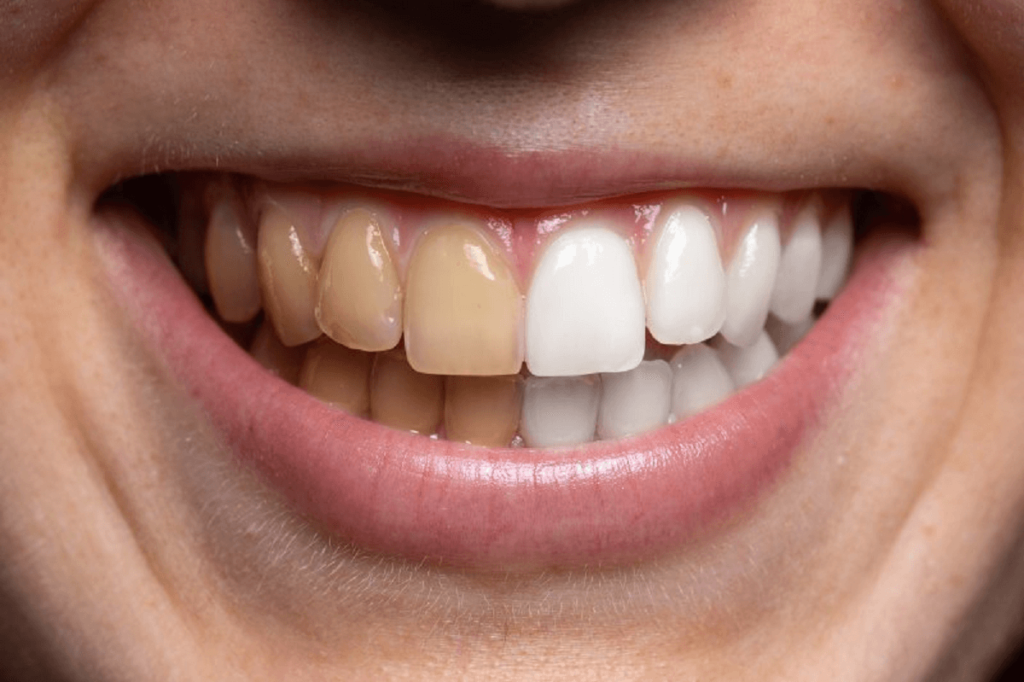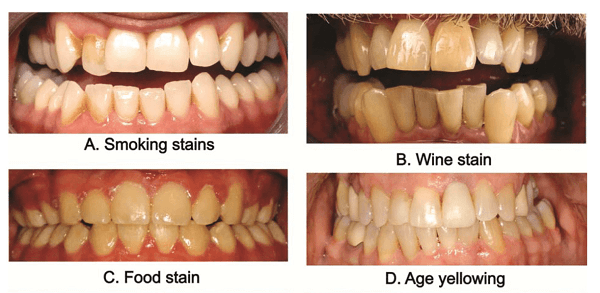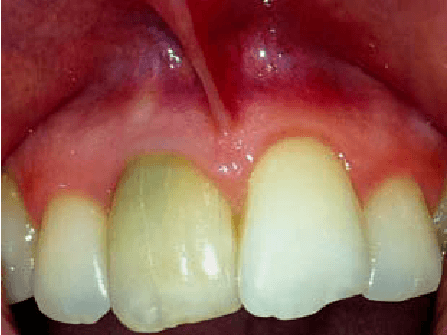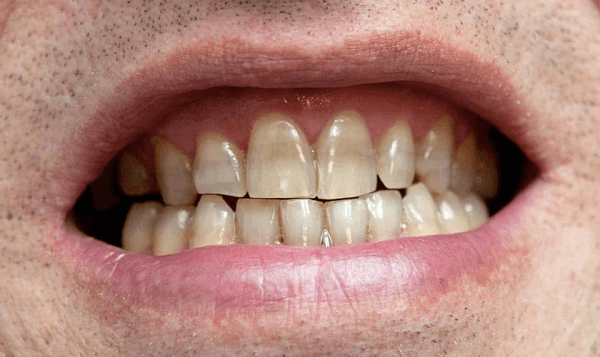Do you feel conscious about stains on your teeth? You’re not alone. Dental stains are super common. There are many reasons behind teeth discoloration, including poor oral hygiene, diet, medication use, and health problems. However, these stains can be easily prevented and treated.
In this article, we’ll discuss types of dental stains. We’ll also look at the reasons behind different types of dental stains and their treatment.

Types of Dental Stains
A lot of people suffer from teeth staining. Dental stains don’t just mean yellow teeth. There are various types of teeth stains, each telling a story about your health. Teeth stains mainly fall under three categories:

Extrinsic Dental Stains
Extrinsic stains affect the enamel of the teeth. Extrinsic stains on teeth are caused by pigment particles in food or drinks like coffee, curry, and berries that adhere to the teeth’s surface. These particles lodge in the microscopic pores of teeth enamel.
Intrinsic Dental Stains
Intrinsic stains affect the inner layer of teeth called dentin. These types of dental stains are difficult to remove as they originate from the teeth’s inner structure. The removal of these stains requires extensive procedures such as crowns, veneers, etc.
Age-Related Dental Stains
Naturally, the enamel wears away with age. This exposes the internal layer of teeth called dentin, which has a yellowish hue that causes dental stains. This is caused by both internal and external factors. External factors include consuming colored food and beverages, smoking, etc.
Different Types of Dental Stains by Color
There are different types of Dental Stain, varying in color. The color of dental stains tells a lot about their cause. Let’s have a look at types of dental stains based on their colors:
- Yellow Stains: Tartar buildup, Dental biofilm
- Brown Stains: Fluorosis, Long-term smoking
- Green Stains: Long-term buildup of chromogenic bacteria
- Black Stains: Iron supplements, Chemicals like manganese and silver
- Gray or Blue Stains: Tetracycline antibiotics, Trauma
- White Stains: Demineralization, Fluorosis
- Orange Stains: Chromogenic bacteria, Poor oral hygiene

Causes of Dental Stains
There are several causes of dental stains. Some of these can be prevented, while others can’t be controlled. Some common causes are listed below:
- Food:
Dark coloured food such as berries, soy sauce, curry, and food coloring can cause different types of dental stains.
- Drinks:
Tea, coffee, wine, sodas, and acidic beverages can also lead to stains on teeth.
- Tobacco:
Smoking or chewing tobacco impacts your overall health and is also a common cause of teeth staining. Nicotine and tar in these products cause brown or yellow stains.
- Poor oral hygiene:
Neglecting oral hygiene is the number one cause of teeth staining. Not brushing properly and skipping floss allows plaque buildup and teeth discoloration.
- Fluorosis:
Excess fluoride consumption in children during teething or after is the reason behind white stains on teeth.
- Trauma:
Accidents resulting in teeth injury also cause stains. Internal bleeding or enamel damage leads to dark stains on teeth.
- Medications:
Certain antibiotics, including tetracycline and minocycline, can cause teeth discoloration. Iron supplements or long-term use of chlorhexidine mouthwash are also culprits of dental stains.
- Diseases:
Health conditions like enamel hypoplasia, liver disease, or metabolic disorders can also affect tooth color.
- Aging:
As discussed before, our teeth become yellow with age. This is due to dentin exposure.
- Genetics:
Some people have naturally yellow teeth this is because of their genetic makeup. makeup.

How to Prevent Dental Stains?
For a bright smile, preventing different types of dental stains is crucial. While you can’t prevent intrinsic stains, external stains can be easily avoided. Here are some simple steps you can follow to keep your teeth shiny:
- Brushing: Brush properly twice a day with the proper technique to avoid plaque buildup. Use a soft-bristled brush and fluoride toothpaste.
- Use Mouthwash: Rinse with an antibacterial or fluoride mouthwash to minimize plaque buildup and staining.
- Floss: Floss removes food particles stuck between teeth which helps in preventing different types of dental stains.
- Limit Staining Foods & Beverages: Limit intake of coffee, tea, red wine, sodas, and dark-colored foods. Drink using a straw to reduce contact with teeth.
- Quit Smoking & Tobacco: Stay away from cigarettes and chewing tobacco; they cause many health problems, including teeth stains.
- Stay Hydrated: Drink water frequently to eliminate food particles and acids that cause staining.
- Get Regular Dental Cleanings: Getting regular professional cleanings helps to remove surface stains, plaque, and tartar.
- Eat Fruits & Vegetables: Apples, carrots, and celery help clean the teeth naturally by encouraging saliva secretion. Hence, eating these helps avoid many types of teeth stains.
- Use Whitening Toothpaste: Select a non-abrasive whitening toothpaste for gentle stain prevention.
Treatment of Dental Stains
There are a number of treatment options for different types of Dental Stain. A few popular options are:
Dental Bonding
In this process, a tooth-colored composite resin is applied to the teeth to cover up stains. Although this is a cost-efficient and least invasive procedure, bonding materials are prone to staining with time and might need regular maintenance.
Veneers
Veneers are thin shells placed over front teeth. They give a strong and resistant finish against types of dental stains. Veneers require enamel removal and are more long-lasting than bonding.
Crowns
Dental crowns cover the entire tooth to restore its shape and function. They are a suitable option for extrinsic types of teeth stains. Aidite’s 3D Pro Zir Zirconia provides a natural shade transition and high translucency, closely replicating natural teeth. With a flexural strength of up to 1,100 MPa, they are ideal for a wide range of restorations, from single crowns to full-arch bridges.

FAQs About Types of Dental Stains
What are dental stains?
Dental stains are spots, patches, or discoloration of the surface of teeth. These stains can either be intrinsic (inner structure of teeth) or extrinsic (on the teeth surface).
How to remove dental stains?
Removing different types of dental stains depends on their severity and cause. Extrinsic stains can be removed easily by going to a dental office and getting regular dental checkups. However, intrinsic dental stains are difficult to remove. They can be removed by addressing the cause of the stains.
Will dental cleaning remove dental stains?
Yes, dental cleaning (scaling and polishing) eliminates extrinsic stains due to plaque and tartar. It also removes surface color change from food, beverages, and smoking. Intrinsic stains (deep stains within the tooth) might be treated with whitening procedures, veneers, or internal bleaching.
How to remove brown stains from teeth naturally?
There are a lot of different natural remedies you can try to remove stains. Some common remedies include using baking soda and hydrogen peroxide, oil pulling, and apple cider vinegar.
Which types of dental stains frequently occur in children?
White stains are commonly caused in children. The reason behind this is excess fluoride use during teething or after.
Final Words
Good dental care and modern treatments have made a bright, white smile very accessible. While prevention decreases different types of dental stains, advanced dental solutions such as whitening treatments, crowns, veneers, etc, have long-lasting results. Aidite, a pioneering company in dental materials, offers excellent zirconia that balance durability and aesthetics. With technologies such as these, having a natural, brilliant smile has never been simpler.



